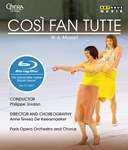|
Back
12/02/2017
Wolfgang Amadeus Mozart: Così fan tutte, K. 588
Singers: Jacquelyn Wagner (Fiordiligi), Michèle Losier (Dorabella), Frédéric Antoun (Ferrando), Philippe Sly (Guglielmo), Paulo Szot (Don Alfonso), Ginger Costa-Jackson (Despina); Dancers: Cynthia Loemij (Fiordiligi), Samantha van Wissen (Dorabella), Julien Monty (Ferrando), Michaël Pomero (Guglielmo), Bostjan Antoncic (Don Alfonso), Marie Goudot (Despina), The Paris Opera Orchestra and Chorus, Alessandro di Stefano (chorus master), Philippe Jordan (conductor), Anne Teresa De Keersmaeker (director/choreographer), Jan Versweyveld (set and lighting designer), An D’Huys (costume designer), Louise Narboni (TV director)
Recording: Palais Garnier, Paris (2017) – 188’
Arthaus Musik 109338 (or Blu-ray 109339) – PCM Stereo, DD 5.1 – Picture format: 16:9 – Region 0 – Booklet in English, French and German – Subtitles in German, English, French and Korean (Distributed by Naxos of America)

   
I am being generous in awarding this release even one eighth-note, but there is some fine talent on display, starting with Philippe Jordan and the Paris Opera Orchestra who give a tangy performance of the overture that evokes the mischief to ensue. The show quickly goes downhill from there.
We are confronted with a bare all-white stage, with some plexiglass panels on the sides and a few cocktail carts. At first the 12 (yes 12) solo performers appear dressed anonymously in black.
Choreographer Anne Teresa De Keersmaeker has staged the work with six dancers from her company Rosas doubling each of the solo singing roles; thus, for example, Paulo Szot as Don Alfonso is shadowed by Bostjan Antoncic doing various supposedly expressive movements as he sings. The costumes of each singer-dancer pair are eventually colour-coded. The singers also participate in stylized movement, much of it minimal. The camera seems desperate to find interesting shots so it spends a lot of time on footwear so we become aware of sparkly spike-heeled pumps, for example. Relationships between the characters is a come-and-go affair, giving the impression of a choreographed concert performance.
Despite the stage direction, some of the singers manage to create a strong impression. (Close camera work helps.) The standouts, as so often in Così, are the two villains. Paulo Szot personifies the charming rogue aspect of Don Alfonso, while Ginger Costa-Jackson looks daggers (“Get out of MY scene!!”) at the dancer (Marie Goudot) who so unnecessarily tries to amplify Despina’s capers. Costa-Jackson embraces the zany hamminess of Despina’s disguises, while the dancer prances around wearing a clown nose just to emphasize the obvious.
Of the four lovers, Frédéric Antoun makes the most vivid and appropriate impression of a responsive character, with some heartfelt soft singing, maintaining a wonderful line. Michèle Losier and Philippe Sly at times express wry amusement, with tepid results. Jacquelyn Wagner seems to be a sincere artist doing her best to look upbeat while marooned in an uncongenial situation. I detect a bit of Stockholm syndrome. Her Fioridiligi has starry potential but it isn’t permitted here.
At the end of Act I everyone runs around in circles. It looks like people exercising at a gym. At times everyone simply falls down. At the end everyone wears gold lamé and rolls around on the floor. Does this sound like fun? It isn’t.
The subtitle for Così is “School for Lovers”, but Keersmaeker’s idea is “The Lovers’ Laboratory” as she explains (but not really) in her booklet essay. The stark white stage certainly evokes this. It is hard to tell what her hypothesis is, but it leads to a nullus resultatum. The experiment is a dud.
Michael Johnson
|